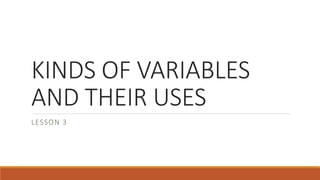
Lesson 3 kinds of variables and thier uses
- 1. KINDS OF VARIABLES AND THEIR USES LESSON 3
- 2. What is a Variable? > It refers to a characteristics or attribute of an individual or an organization that can be measured or observed and that varies among people or organization being studied. > The most common variables in social research are age, sex, gender, education, income, marital status and occupation.
- 3. The Nature of Variables and Data 1. NOMINAL VARIABLES represents categories that cannot be ordered in any particular way. These are variables whose data are non-numeric labels that do not reflect quantitative information Example: gender, political affiliation, social status 2. ORDINAL VARIABLES represents categories that can be ordered from smallest to greatest. It refers to variables where there is a meaningful order or categories but there is no measurable distance between categories Example: grade level, sibling rank
- 4. The Nature of Variables and Data 3. INTERVAL VARIABLES –values that lie along an evenly dispersed range of numbers. It is a variable whose data values are ranged in a real interval and can be as large as from negative infinity to positive infinity. Example: Temperature, IQ Level 4. RATIO VARIABLES have values that lie along an evenly dispersed range of numbers when there is an absolute zero.
- 5. Kind of Variables 1. Independent Variables- those that probably cause influence or affect outcomes. They are invariably called treatment, manipulated, antecedent or predictor variables. 2. Dependent variables-those that depend on the independent variables; they are the outcomes of the influence of the independent variable. 3. Intervening or Mediating Variable – “stand between” the independent and dependent variables and they show the effects of the independent variable on the dependent variable.
- 6. Kind of Variables 4. Control Variables –special type of independent variables that are measured in a study because they influence the dependent variable. Researchers use statistical procedures (analysis of covariance [ANCOVA]) to control these variables. 5. Confounding variables-those that are not actually measured or observed in a study. They exist but their influence cannot be directly detected in a study.
- 7. Example of Variables related to a phenomenon Phenomenon: Climate Change Examples of variables related to climate change: 1. Sea level 2. temperature 3. The amount of carbon emission 4. the amount of rainfall
- 8. Example of Variables related to a phenomenon Phenomenon: Crime and violence on streets Examples of variables related to Crime and violence on streets: 1. Number of robberies 2. number of attempted murders 3. Number of prisoners 4. number of victims 5. Number of law enforcers 6. Number of convictions 7. number of carnapping incidents
- 9. Example of Variables related to a phenomenon Phenomenon: Poor performance of students in college entrance exams Examples of variables related to Poor performance of students in college entrance exams: 1. Entrance exam scores 2. Study time 3. Student-teacher ratio 4. Education attainment 5. Teaching style 6. Distance of school from home 7. Parents involvement in tutoring their students
- 10. seatwork Directions: Write Survey or Experiment, indicating the kind of quantitative research you will use, given the following problems you as researcher you intent to investigate. 1. How many students use the university library between 7am and 8am.? 2. How many hours adolescents do Facebook in a day? 3. The most frequently used students service in your school. 4. the impact of blending learning on students enrolled in Research.
- 11. seatwork Directions: Write Survey or Experiment, indicating the kind of quantitative research you will use, given the following problems you as research you intent to investigate. 5. the number of students who read the broadsheets. 6. the food preference of teachers. 7. the effects of coaching on the academic performance of grade 12 students. 8. The impact of cooperative stores on selected barangay. 9. The results of a prescribed daily diet on the sugar count of diabetic patients. 10. The correlation of admission test results of high school graduates under the Alternative learning system.